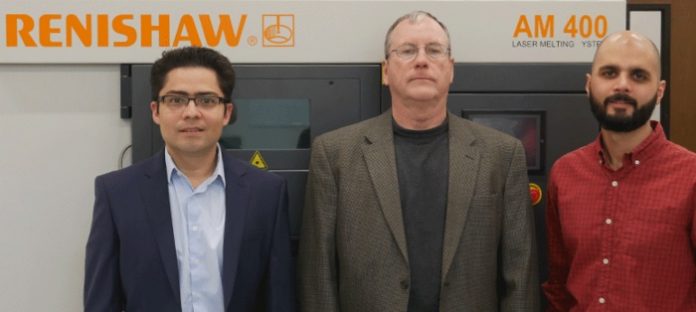Researchers from the Margie and Bill Klesse College of Engineering and Integrated Design at UTSA are advancing work on a three-year, $659,970 grant from the U.S. Department of Defense’s Army Research Office to improve the military’s capacity to produce parts for critical machinery including aircraft. The researchers will focus on increasing the reliability of the additive manufacturing (AM) or metal 3D-printing process.
The research team includes David Restrepo, assistant professor in the UTSA Department of Mechanical Engineering; Harry Millwater, the department’s Samuel G. Dawson Endowed Professor; and Arturo Montoya, associate professor of mechanical engineering and civil and environmental engineering. They have been working on new computational designs that could lead to a more reliable additive-manufactured product.
AM is a rapidly growing segment of the engineering industry, expected to grow from $14 billion in 2018 to more than $350 billion by 2035.
Working directly from a digital model, additive manufacturing 3D-prints objects layer by layer, enabling new designs and innovations that were not possible before. Unlike the traditional manufacturing process, AM makes it possible to develop custom-made parts on-site for specific uses, mitigating issues such as transport, storage, long lead times and considerable excess inventory.
The drawback to AM is a lack of quality fabricated parts. AM involves laser-heating powders to create a shape, a process known as laser sintering. One significant challenge with the current technology is the uncertainty of the mechanical properties and the stability of the components when the powder cools and solidifies.
“One of the challenges of metal AM is the difficulty of knowing with 100% certainty what the mechanical properties (such as stiffness and strength) are in the printed components,” Restrepo explained. “It is also challenging to predict or reduce the dimensional variability of the components when compared with the design specifications. These challenges mean that printed parts currently cannot be certified to use in critical components—those that, if a failure occurs, may compromise human lives.”
Restrepo added, “We are modeling the laser sintering process to predict the mechanical properties and dimensional stability of the components fabricated with AM. The unique ingredient in our models is a UTSA-developed technology for sensitivity analysis. This unique technology will allow us to predict the mechanical properties, reliability and qualifications of AM-generated parts.”
The team’s research has been made possible through the resources in the UTSA Makerspace. The researchers are using its recently unveiled Renishaw 3D printer, a philanthropic donation by long-time supporter Edward Whitacre Jr.
Renishaw’s 3D printing technology is an integral part to the research project. It allows faculty members and student researchers to fabricate parts and collect data that will either affirm their computational models or illuminate necessary changes to calculations.
“UTSA’s state-of-the art Makerspace offers technology to students and faculty that greatly expands opportunities to conduct research, explore and build,” Millwater said. “The 3D Renishaw printer is an industry-leading tool that our students can work with throughout their time as a Roadrunner so they emerge ready to contribute to their careers from day one.”
“As the use of AM proliferates throughout more and more business sectors, exposing our students to its applications throughout their degree programs is of increasing importance,” Montoya added. “Whether students will employ AM in their careers, a functional understanding of the practice is particularly useful for the engineers of the future.”
Four additional mechanical engineering researchers at varying levels are working on the project including undergraduate Tim Clairmont, graduate student Aaron Rios, doctoral candidate Juan Sebastian Rincon and postdoctoral fellow Mauricio Aristizabal.
Restrepo stated that he is always looking for new opportunities for students to engage with hands-on research as part of their studies.
“In my experience, all of the professors at UTSA are happy to bring students into their research projects,” he said. “If you’re interested, stop by office hours or send an email to a professor pursuing research that interests you.”
“Our students are offered many opportunities to develop hands-on skills through experiential learning opportunities, such as this research project,” added JoAnn Browning, dean of the Klesse College. “Our new Makerspace and the technology it houses only furthers the potential for students to engage in unparalleled research and design opportunities, beginning as early as freshman year of their undergraduate degrees.”
UTSA is an urban serving Tier One research institution that is committed to tackling society’s grand challenges. It is driving San Antonio’s knowledge economy, living out the notion that great universities need great cities and great cities need great universities.
The UTSA Classroom to Career initiative incorporates experiential learning, including internships, service learning, undergraduate research and study abroad to help students gain the skills in demand by employers. The program is particularly important in linking classroom success to life after graduation for historically underserved populations. As part of its strategic plan, UTSA aims for 75% of its undergraduate students to participate in some type of experiential learning by the time they graduate.








